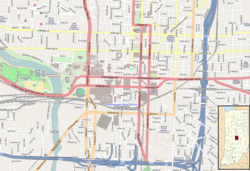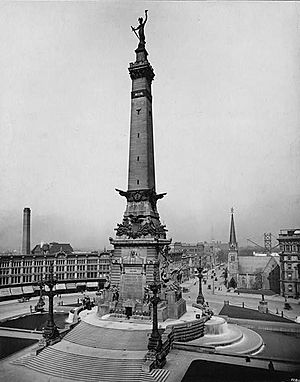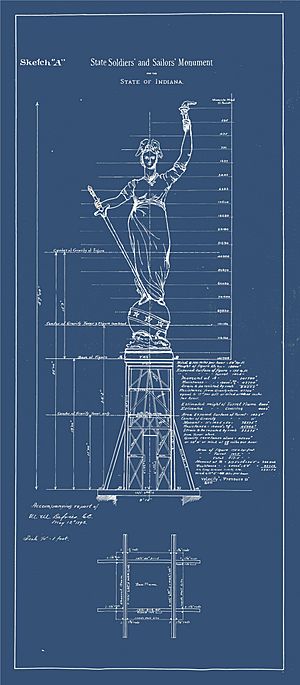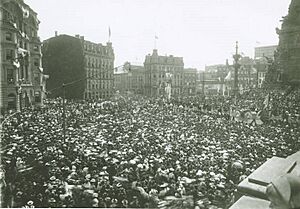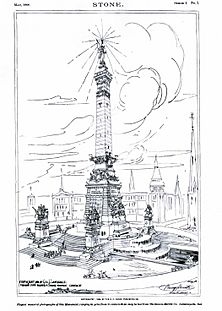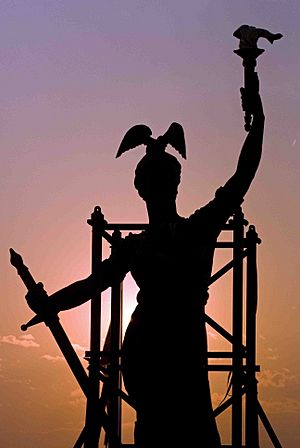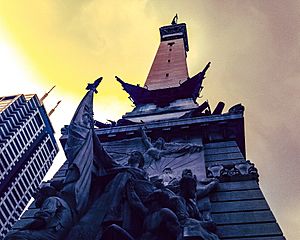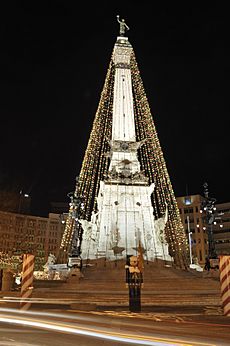Soldiers' and Sailors' Monument (Indianapolis) facts for kids
|
State Soldiers and Sailors Monument
|
|
|
U.S. National Historic Landmark District
Contributing Property |
|

Soldiers' and Sailors' Monument, seen from the Sheraton Indianapolis City Centre in 2014.
|
|
| Location | Monument Circle Indianapolis, Indiana, US |
|---|---|
| Area | 1 acre (0.40 ha) |
| Built | 1888 |
| Architect | Bruno Schmitz |
| Part of | Indiana World War Memorial Plaza Historic District (ID89001404) |
| NRHP reference No. | 73000040 |
Quick facts for kids Significant dates |
|
| Added to NRHP | February 23, 1973 |
| Designated NHLDCP | December 23, 2016 |
The Indiana State Soldiers and Sailors Monument is a huge monument in the middle of downtown Indianapolis, Indiana. It stands 284 ft 6 in (86.72 m) tall. This monument is built in a style called Neoclassicism, which means it looks like ancient Greek and Roman buildings.
It sits on a round, brick-paved street known as Monument Circle. This circle crosses Meridian and Market streets. Since it was officially opened on May 15, 1902, the monument has become a famous symbol of Indianapolis. Indianapolis is the capital city of Indiana.
The monument was added to the National Register of Historic Places on February 13, 1973. It is also part of a larger historic area called the Indiana World War Memorial Plaza Historic District. This monument is the biggest outdoor memorial of its kind in Indiana.
A German architect named Bruno Schmitz designed the monument. It took thirteen years to build, from 1888 to 1901. The monument was first made to honor Indiana soldiers who fought in the American Civil War. However, it also honors soldiers from other wars. These include the American Revolutionary War, the War of 1812, the Mexican–American War, and the Spanish–American War. It was the first monument in the United States to honor the "common soldier."
The monument looks like a tall, pointed pillar called an obelisk. It is made from oolitic limestone from Owen County, Indiana. It stands on a raised base with pools and fountains around it. Wide stone steps on the north and south sides lead to two flat areas at its bottom.
Above the bronze doors on the north and south sides, stone tablets honor Indiana's soldiers. One message above these tablets says: "To Indiana's Silent Victors." You can go inside the monument and take stairs or an elevator to an observation deck at the top. From there, you can see amazing views of the city.
The statues and fountains are mostly made of limestone and bronze. When the monument was finished in 1902, it cost about $598,318. Building something similar today would cost more than $500 million!
The monument has many cool outdoor sculptures. These include two large limestone groups called War and Peace by Rudolph Schwarz. There are also smaller scenes like The Dying Soldier and The Return Home. Four military figures stand at the base. Three bronze bands, called astragals, wrap around the stone obelisk. One is by Nikolaus Geiger and two are by George T. Brewster.
Other sculptures include bronze statues by John H. Mahoney of George Rogers Clark, William Henry Harrison, and James Whitcomb. There is also a bronze statue of Oliver P. Morton by Franklin Simmons. A 30-foot (9.1 m) bronze statue called Victory by Brewster sits on top of the obelisk. The Indianapolis monument is about 21 feet (6.4 m) shorter than the 305-foot (93 m) Statue of Liberty in New York City.
Contents
History of the Monument
The land where the monument stands was once a public gathering place. It was also the site of the Indiana governor's home and a city park. Building the monument started in 1888 and it was officially opened in 1902.
Early Days: Governor's Circle
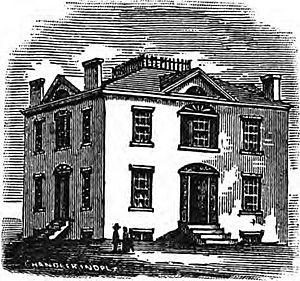
When Indianapolis was first planned in 1821, it included a circular street 80-foot (24 m) wide. This street surrounded a 3-acre (1.2 ha) circular piece of land. This central spot was first called the Governor's Circle. It was meant to be where the Indiana governor would live.
From 1821, the Circle was a busy place for the community. People gathered there for church services before churches were built. A weekly market was held there from 1822 to 1824.
A governor's home was built on the Circle in 1827. But no governor ever lived there. This was because it was too public and not built very well. Instead, it was used as offices for the Indiana Supreme Court and the Indiana State Library. It also hosted many public events. These included parties for new governors, charity fundraisers, and Fourth of July celebrations. By 1851, the building was falling apart. It was torn down in 1857, leaving an empty space.
As Indianapolis grew after the Civil War, the Circle became a popular spot. People met there for large gatherings, public speeches, and to celebrate wartime victories. In 1867, the area was cleaned up, fenced, and named Circle Park. It stayed empty until 1884. That year, a bronze statue of Oliver P. Morton was put in the center. Morton was Indiana's governor during the Civil War.
Franklin Simmons, an American sculptor, created the statue of Morton. It was surrounded by an iron fence. The dedication ceremony for the statue happened on June 15, 1884.
Ideas for a Monument
After the Civil War, many people suggested building a monument to honor Indiana's Civil War soldiers. The first idea came in 1862. An article in the Indianapolis Daily Journal suggested a monument in Circle Park. But nothing happened then.
Talk about a monument continued for years. In 1867, Governor Morton suggested a monument at Crown Hill Cemetery. This idea also did not happen. In 1872, a bill to build a monument failed in the state legislature. Other places suggested for the monument included University Park and Military Park.
Progress finally began in August 1875. George J. Langsdale, a newspaper editor, presented a plan for a memorial. This was during the first reunion of Civil War veterans in Indianapolis. His idea was popular, and a monument group was formed. By 1887, the Grand Army of the Republic had raised $23,380. They then gave the responsibility for the monument to the State of Indiana.
On March 3, 1887, the Indiana General Assembly passed a bill. This bill created a monument commission. The bill also said the monument should be built in Indianapolis. It set aside $200,000 for the project. Some lawmakers disagreed about using the Circle for the monument. However, the law clearly stated that Circle Park was the chosen site.
Building the Monument
To choose a design, the commission held an international contest. They asked ten architects to submit ideas. Notices were also put in newspapers around the world. Seventy designs were submitted by the deadline of January 12, 1888.
The selection committee chose two designs. They picked Bruno Schmitz, an architect from Berlin, Germany, as the winner. His design was called Symbol of Indiana. Schmitz was an expert in monument design.
Many people and companies helped build the monument. Schmitz became the main architect in February 1888. His pay was five percent of the total cost. Frederick Bauman from Chicago was his assistant. Enos Hege built the monument's foundation in 1888. Thomas McIntosh became the project's superintendent. The Terre Haute Stone Works Company built the terraces and the main structure.
The sculptors who worked on the stone and bronze parts were Rudolph Schwarz, Nikolaus Geiger, George Brewster, and John Mahoney. Construction continued using Schmitz's design.
The first stone was laid on August 22, 1889. Inside, a copper box was placed. It held a list of all Indiana soldiers from the Civil War, newspapers, and other items. President Benjamin Harrison gave a speech at the ceremony. It was the first monument in the United States to honor the common soldier.
More money was needed to finish the project. The state legislature gave an extra $160,000. In 1891, they raised over $123,000 with a new property tax. The monument took thirteen years to build. The tall obelisk part was finished in 1892. The main parts were done by 1894, and the final touches were added in 1901. In 1893, the Circle was renamed Monument Place. The total cost was $598,318.
Monument Dedication
The monument was officially opened on May 15, 1902. Thousands of people came to the event. It started at 8 a.m. with a parade of flags and veterans. It ended with fireworks in the evening.
The main ceremony was at 10 a.m. General Lew Wallace was the host. Governor Winfield T. Durbin and others gave speeches. A male choir sang, and poet James Whitcomb Riley read his poem "The Soldier." This poem was written just for the event. Musicians played John Philip Sousa's "The Messiah of the Nations," a march he wrote for the occasion.
Later History and Changes
The monument has been changed and updated many times since 1902.
- In 1918, a museum opened in the basement of the monument. It had items from the Civil War.
- Since 1945, the monument has been decorated for Christmas. In 1962, it was first decorated as the "world's largest Christmas tree."
- The monument was added to the National Register of Historic Places on February 13, 1973.
- In September 2009, repairs began. Windows were replaced, and steel supports for the Victory statue were changed. The observation deck reopened in November 2009.
- In April 2011, the Victory statue was taken down for cleaning and repairs. It was then put back on top of the monument.
Monument's Exterior Design
The monument stands in the middle of Monument Circle. This is a round, brick-paved street in downtown Indianapolis. The monument is a neoclassical obelisk. It is made of oolitic limestone from quarries in Owen County, Indiana.
It sits on a raised foundation 30 feet (9.1 m) deep, surrounded by pools and fountains. Wide stone steps on the north and south sides are 70 feet (21 m) long. They lead to two flat areas at the monument's base. The base of the obelisk is 52 feet (16 m) wide. It narrows to 12 feet (3.7 m) near the top.
The obelisk and its Victory statue on top are 284 ft 6 in (86.72 m) tall. It is 15 feet (4.6 m) shorter than the Statue of Liberty in New York City. Eight stone eagles hold up the top part, which has a balcony. A 19-foot (5.8 m) tower supports the Victory statue.
Limestone tablets above the bronze doors honor Indiana's soldiers. They remember those who fought in the American Revolutionary War and the Siege of Fort Vincennes. They also honor soldiers from the War of 1812 and related Indian wars. Soldiers from the Mexican–American War and the American Civil War are also honored. A message above the tablets says: "To Indiana’s Silent Victors."
Monument Sculptures
Bruno Schmitz hired Rudolph Schwarz, a sculptor from Austria. Schwarz created War and Peace, two large limestone groups for the monument. He also added two smaller scenes: The Dying Soldier and The Return Home. Schwarz carved four military figures for the base. These represent the artillery, cavalry, infantry, and navy. He also made the bronze entrance doors.
Three bronze bands, called astragals, wrap around the stone obelisk. One is by Nikolaus Geiger and two are by George Brewster. The first band is 70 feet (21 m) above the base. The second is 12 feet (3.7 m) above the first. The third is 80 feet (24 m) above the base, below the top. Geiger, from Berlin, Germany, made the first band. It shows a battlefield scene with the army. He died before the monument was finished.
Brewster, an American sculptor, made the second band with a naval theme. It includes a picture of Admiral David Farragut. Brewster also designed the third band. It has the dates 1861 and 1865, which are the start and end years of the Civil War.
Brewster's Victory statue is on top of the monument. Schmitz wanted a classical sculpture of a winged Nike. Nike is the Greek goddess of victory. This statue became known as Indiana or Miss Indiana. It is 30 feet (9.1 m) tall and weighs ten tons. It faces south and cost $12,500. The statue holds a sword, which means victory. It also has a torch, which means "the light of civilization," and an eagle, a symbol of freedom.
Other outdoor sculptures include bronze statues by John Mahoney. These are of George Rogers Clark, William Henry Harrison, and James Whitcomb. There is also Franklin Simmons's bronze statue of Oliver P. Morton. The statue of Morton, Indiana's governor from 1861 to 1867, was first put in the center of the Circle in 1884. When the new monument was built, Morton's statue was moved. It was put on the southeast side of the monument around 1899. It represents Indiana's part in the Civil War.
In 1895, Mahoney was asked to create three more sculptures. These would show Indiana's role in earlier wars. His statue of Clark is on the northwest side. It represents the American Revolution. The statue of Harrison, a hero of the battle of Tippecanoe, is on the northeast side. It represents the War of 1812. The statue of James Whitcomb, Indiana's governor from 1843 to 1848, is on the southwest side. It represents the Mexican–American War.
In 1894, the original fountains were replaced with bigger ones. Four large candelabra, each 40 feet (12 m) tall, were put on pedestals. These were at the north and south steps. Smaller candelabra were placed around the monument. They lit up the drinking fountains, which were shaped like bronze buffalo heads.
Inside the Monument
You can take an elevator or stairs to reach the observation deck inside the monument. The first elevator started working in 1894. The elevator stops just below the observation deck. You then need to climb 31 more steps to reach the very top. The staircase has 331 steps in total.
The monument also has a gift shop. The basement of the monument used to have the Colonel Eli Lilly Civil War Museum. But water leaks in 2018 made the museum move to the Indiana War Memorial building. In 2019, over 369,000 people visited the monument.
Monument's Importance
Since it was opened on May 15, 1902, the monument has become a famous symbol of Indianapolis. It was the first monument in the United States to honor the "common soldier." It is also the biggest outdoor memorial of its kind in Indiana. The monument was added to the National Register of Historic Places on February 13, 1973.
In 2011, the American Planning Association called Monument Circle one of the nation's "great public spaces."
The local soccer team, Indy Eleven, uses the Victory statue in their logo. The Indianapolis city police also have the monument on their badge.
Monument Circle Around the Monument
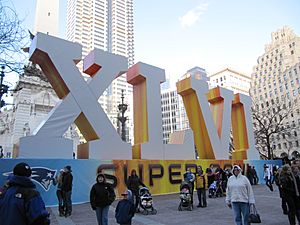
The monument is surrounded by Monument Circle, which is 342-foot (104 m) wide. The Circle is full of shops, radio station studios, and the Hilbert Circle Theatre. This theater is home to the Indianapolis Symphony Orchestra. There are also banks, the Columbia Club, Christ Church Cathedral, and the AES Indiana company headquarters.
Monument Circle is a popular public gathering place in Indianapolis. People come here for concerts, political events, and to take photos.
The flag of Indianapolis shows a picture of Monument Circle. It also shows the two streets (Meridian and Market) that cross it.
Circle of Lights
During the Christmas season, the monument is decorated like a giant Christmas tree. This yearly city tradition is called the "Circle of Lights." It started in 1962. The tree lighting ceremony happens the day after Thanksgiving.
Volunteers from the local IBEW put up 4,784 lights and 52 strands of garland. More than 100,000 people come to the ceremony. The event is also shown on TV to about 50,000 homes.
Gallery
-
View of the monument from the southwest, with the Salesforce Tower in the background.
See also
 In Spanish: Monumento Círculo para niños
In Spanish: Monumento Círculo para niños


